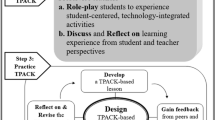Abstract
This conceptual paper argues that to develop students’ twenty first century competencies, teachers need to consider how technological pedagogical content knowledge (TPACK) can be applied through design thinking processes. It proposes a conceptual framework articulating various TPACK considerations and how these various forms of TPACK can be used as epistemic resources to support design thinking for developing ICT-integrated lessons targeted at twenty first century learning. This framework provides an initial vocabulary for describing how teachers create TPACK through design, which is a critical gap in extant TPACK research. Implications for teachers’ design of ICT-integrated lessons as well as future directions of research are discussed.

Similar content being viewed by others
References
Angeli, C., & Valanides, N. (2009). Epistemological and methodological issues for the conceptualization, development, and assessment of ICT-TPCK: Advances in technological pedagogical content knowledge (TPCK). Computers & Education, 52(1), 154–168.
Archambault, L. M., & Barnett, J. H. (2010). Revisiting technological pedagogical content knowledge: Exploring the TPACK framework. Computers & Education, 55(4), 1656–1662.
Bereiter, C., & Scardamalia, M. (2006). Education for the Knowledge Age. In P. A. Alexander & P. H. Winne (Eds.), Handbook of educational psychology (2nd ed., pp. 695–713). Mahwah: Lawrence Erlbaum.
Brown, T. (2009). Change by design: How design thinking transforms organizations and inspires innovation. Boston, MA: HarperBusiness.
Cameron, L. (2006). Picture this: My Lesson. How LAMS is being used with pre-service teachers to develop effective classroom activities. Paper presented at The First International LAMS Conference : Designing the Future of Learning, Sydney, Australia.
Chai, C. S., Koh, J. H. L., Ho, H. N., & Tsai, C. C. (2012). Examining preservice teachers’ perceived knowledge of TPACK and cyberwellness through structural equation modeling. Australasian Journal of Educational Technology, 28(6), 1000–1019.
Chai, C. S., Koh, E., Lim, C. P., & Tsai, C.-C. (2014). Deepening ICT integration through multilevel design of technological pedagogical content knowledge. Journal of Computers in Education, 1(1), 1–17.
Collins, A. (1996). Design issues for learning environments. In S. Vosniadou, E. E. Corte, R. Glaser, & H. Mandl (Eds.), International perspectives on the design of technology-supported learning environments (pp. 347–361). Hisdale: Lawrence Erlbaum Associates Inc.
Cox, S., & Graham, C. R. (2009). Diagramming TPACK in practice: Using and elaborated model of the TPACK framework to analyze and depict teacher knowledge. TechTrends, 53(5), 60–69.
Coyne, R. (2005). Wicked problems revisited. Design Studies, 26(1), 5–17.
Cross, N. (2001). Designerly ways of knowing: Design discipline versus design science. Design Issues, 17(3), 49–55.
Cross, N. (2004). Expertise in design: An overview. Design Studies, 25(5), 427–441.
Cross, N. (2011). Design thinking. NY: Berg.
Dorst, K. (2006). Design problems and design paradoxes. Design Issues, 22(3), 4–17.
Dorst, K. (2011). The core of ‘design thinking’and its application. Design Studies, 32, 521–532.
Dym, C., Agogino, A., Eris, O., Frey, D., & Leifer, L. (2005). Engineering design thinking, teaching, and learning. Journal of Engineering Education, 94(1), 103–120.
Ertmer, P. A. (1999). Addressing first and second-order barriers to change: Strategies for technology integration. Educational Technology Research and Development, 47(4), 47–61.
Eteokleous, N. (2008). Evaluating computer technology integration in a centralized school system. Computers & Education, 51(2), 669–686.
Grant, D. (1979). Design methodology and design methods. Design Methods and Theories, 13(1), 46–47.
Heinich, R., Molenda, M., Russell, J., & Smaldino, S. (1999). Instructional media and technologies for learning (6th ed., pp. 7–92). Columbus, OH: Prentice-Hall.
Hong, H. Y., & Sullivan, F. R. (2009). Towards an idea-centered, principle-based design approach to support learning as knowledge creation. Educational Technology Research and Development, 57(5), 613–627.
Hong, H. Y., Zhang, J., Teo, C., & Scardamalia, M. (2009). Towards design-based knowledge-building practices in teaching. Paper presented at the Proceedings of the 9th international conference on Computer supported collaborative learning-Vol 1 (pp. 257-261).
Howland, J. L., Jonassen, D., & Marra, R. M. (2012). Meaningful learning with technology (4th ed.). Boston: Allyn & Bacon.
Jang, S.-J., & Chen, K.-C. (2010). From PCK to TPACK: Developing a transformative model for pre-service science teachers. Journal of Science Education and Technology, 19(6), 553–564.
Kershner, R., Warwick, P., Mercer, N., & Kleine Staarman, J. (2014). Primary children’s management of themselves and others in collaborative group work:‘Sometimes it takes patience…’. Education 3–13: International Journal of Primary, Elementary and Early Years Education, 42(2), 201–216.
Koehler, M. J., Mishra, P., & Yahya, K. (2007). Tracing the development of teacher knowledge in a design seminar: Integrating content, pedagogy and technology. Computers & Education, 49(3), 740–762.
Koh, J. H. L., Chai, C. S., & Tay, L. Y. (2014). TPACK-in-action: Unpacking the contextual influences of teachers’ construction of technological pedagogical content knowledge (TPACK). Computers & Education, 78, 1–10.
Koh, J. H. L., Chai, C. S., & Tsai, C. C. (2013). Examining practicing teachers’ perceptions of technological pedagogical content knowledge (TPACK) pathways: A structural equation modeling approach. Instructional Science, 41(4), 793–809. doi:10.1007/s11251-012-9249-y.
Kozma, R. B. (2008). Comparative analysis of policies for ICT in education International handbook of information technology in primary and secondary education (pp. 1083–1096). USA: Springer.
Laurillard, D. (2012). Teaching as a design science: Building pedagogical patterns for learning and technology. New York, NY: Routledge.
Lawson, B. (1997). How designers think: the design process demystified. Oxford: Architectural Press.
Lawson, B., & Dorst, K. (2009). Design expertise (Vol. 31). Oxford: Architectural Press.
Levin, T., & Wadmany, R. (2008). Teachers’ views on factors affecting effective integration of information technology in the classroom: Developmental scenery. Journal of Technology and Teacher Education, 16(2), 233.
Lim, C. P., & Chai, C. S. (2008). Teachers’ pedagogical beliefs and their planning and conduct of computer-mediated classroom lessons. British Journal of Educational Technology, 39(5), 807–828.
Lin, X. D., Hmelo, C., Kinzer, C., & Secules, T. (1999). Designing technology to support reflection. Educational Technology Research and Development, 47(3), 43–62.
Metiri Group, & NCREL. (2003). EnGauge twenty first century skills: Literacy in the digital age. Chicago: IL NCREL.
Mishra, P., & Koehler, M. J. (2006). Technological pedagogical content knowledge: A framework for teacher knowledge. Teachers College Record, 108(6), 1017–1054.
Niess, M. L. (2013). Central component descriptors for levels of technological pedagogical content knowledge. Journal of Educational Computing Research, 48(2), 173–198.
OECD. (2005). The definition and selection of key competencies: Executive summary. Paris: Organization for Economic Cooperation and Development.
Oxman, R. (1999). Educating the designerly thinker. Design Studies, 20(2), 105–122.
P21. (2007). Maximizing the impact: The pivotal role of technology in a twenty first century education system. Retrieved from http://www.p21.org/documents/p21setdaistepaper.pdf
Rittel, H. W. J., & Webber, M. M. (1973). Dilemmas in a general theory of planning. Policy Sciences, 4(2), 155–169.
Rosenberg, S., Hammer, D., & Phelan, J. (2006). Multiple epistemological coherences in an eighth-grade discussion of the rock cycle. The Journal of the Learning Sciences, 15(2), 261–292.
Rowe, P. G. (1991). Design thinking. Cambridge: The MIT Press.
Rowland, G. (2004). Shall we dance? A design epistemology for organizational learning and performance. Educational Technology Research and Development, 52(1), 33–48.
Sandoval, W. A. (2003). Conceptual and epistemic aspects of students’ scientific explanations. The Journal of the Learning Sciences, 12(1), 5–51.
Schön, D. A. (1983). The reflective practitioner: How professionals think in action. New York: Basic Books.
Shulman, L. S. (1999). Knowledge and teaching: Foundations of the new reform Learners and pedagogy (pp. 61–77). London: Paul Chapman Publishing Ltd.
Simon, H. A. (1996). The sciences of the artificial. Cambridge: The MIT Press.
Starkey, L. (2010). Teachers’ pedagogical reasoning and action in the digital age. Teachers and Teaching: Theory and Practice, 16(2), 233–244.
Summerville, J., & Reid-Griffin, A. (2008). Technology integration and instructional design. TechTrends, 52(5), 45–51.
Tondeur, J., Van Keer, H., van Braak, J., & Valcke, M. (2008). ICT integration in the classroom: Challenging the potential of a school policy. Computers & Education, 51(1), 212–223.
Tsai, C. C., & Chai, C. S. (2012). The “third”-order barrier for technology-integration instruction: Implications for teacher education. Building the ICT capacity of the next generation of teachers in Asia. Australasian Journal of Educational Technology, 28, 1057–1060.
Voogt, J., Fisser, P., Roblin, N. P., Tondeur, J., & van Braak, J. (2013). Technological pedagogical content knowledge—a review of the literature. Journal of Computer Assisted learning, 29(2), 109–121.
Voogt, J., & Roblin, N. P. (2012). A comparative analysis of international frameworks for twenty first century competences: implications for national curriculum policies. Journal of Curriculum Studies, 44(3), 299–321.
Ward, L., & Parr, J. M. (2010). Revisiting and reframing use: Implications for the integration of ICT. Computers & Education, 54(1), 113–122.
Windschitl, M. (2002). Framing constructivism in practice as the negotiation of dilemmas: An analysis of the conceptual, pedagogical, cultural, and political challenges facing teachers. Review of Educational Research, 72(2), 131–175.
Zhang, J., Hong, H.-Y., Scardamalia, M., Teo, C. L., & Morley, E. A. (2011). Sustaining knowledge building as a principle-based innovation at an elementary school. Journal of the Learning Sciences, 20(2), 262–307.
Zhao, Y., & Frank, K. A. (2003). Factors affecting technology uses in schools: An ecological perspective. American Educational Research Journal, 40(4), 807–840.
Author information
Authors and Affiliations
Corresponding author
Rights and permissions
About this article
Cite this article
Koh, J.H.L., Chai, C.S., Benjamin, W. et al. Technological Pedagogical Content Knowledge (TPACK) and Design Thinking: A Framework to Support ICT Lesson Design for 21st Century Learning. Asia-Pacific Edu Res 24, 535–543 (2015). https://doi.org/10.1007/s40299-015-0237-2
Published:
Issue Date:
DOI: https://doi.org/10.1007/s40299-015-0237-2




